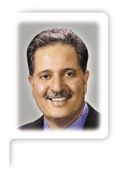Article
How do you help patients understand prostate cancer treatment options?
Three urologists discuss how they review prostate cancer treatment options with their patients.

“We look at the variables: their age, their health, and then try to pick the best treatment for each, whether it’s surgery, radiation, hormone blockade, or watchful waiting. Some can feel overwhelmed; it depends on the patient. Some respect your opinion and will do what you feel is right. Others are out there searching, and are confused by so many controversies and so many treatments. We try to simplify things by putting them into perspective by the variables.
It does get more complicated because of changing insurance payments and restrictions on what procedures will be covered and where. That’s an additional problem we have to explain to the patients and get them to a facility that is appropriate for them.
Some patients end up deciding on their treatment based on those insurance parameters rather than on what they actually want.”
J. Anthony Shaheen, MD
Monterey, CA
“It’s not really a big issue in my practice. It may be different here than in other areas of the country, but most men who come in already have a fairly good idea of what they want to do. Most have already done a lot of research on the Internet and are educated about what their options are and what they think they will be comfortable with.
I’ll go over the options based on their particular disease, depending on risk factors and comorbidities, and make my recommendations. They’ll tell me what they think should be done, and then we’ll come to some common consensus proceed on that basis. If they have particularly strong feelings about an approach that might not be my first choice, but which I think is reasonable, I’ll go along with it because patients do have to be informed and make decisions about their own health.”
Henry Abrams, MD
New Hyde Park, NY
“That’s a good question. You have to simplify it to some degree, and sometimes it’s more difficult than others.
I try to stratify the options based on the disease they have. Based on that, I’ll talk about the options and explain the risks of each. Certainly for high-risk patients, we’ll typically be more pro-surgery. For patients who are moderate risk, I’ll lay out all the options as far as radiation versus surgery versus watchful waiting and let them make an informed decision.
I don’t try to rush the process. We try to give them plenty of time to make a decision. Once they’re diagnosed, it seems people who have had the disease before come out of the woodwork and talk to them. Their friends share their experiences and what they went through, and oftentimes that is helpful. The patient will come back, and in the end, they’ll decide what they want to do.
I tell them there are a lot of options, but it’s not like ‘pick-a-card-any-card’ and things will be fine. I’m there to help recommend what card to pick, based on what they have. Some patients could pick almost anything, while others want to be treated aggressively and we have to try to rein them back.
Everybody’s a little different, and that’s how I try to approach it.”
Harold Blalock, MD
Jackson, MS

















